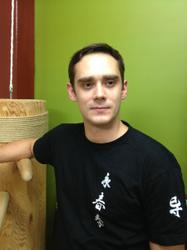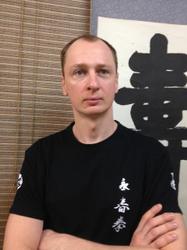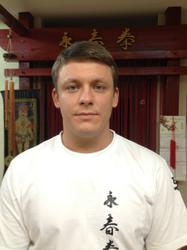The Mime Club
 General concept
General concept
Object: the development of an educated social class which would contribute to the progress and prosperity of a new Russia by means of the proper upbringing of the upcoming generation culturally, ethically and spiritually.
Motto: Recognition of Beauty. A Clear and bright mind saves the world.’
Activities are assigned by the Club Executive Committee.
General areas of activity are:
1. Mime cultural heritage analysis through the use of books and videos.
2. Holding educational seminars and conferences.
3. Group- and single-performer consultations.
4. Education of teachers for the club’s affiliated branches, mime companies and theatres.
5. Mime trend analysis and development (classical, philosophical, genre, allegorical, abstract, conceptual, etc.).
Club Membership. Club membership is granted to physical and legal persons, i.e. mime group leaders, single performers and sponsors.
Applications for club membership should be addressed to the following tel.:8(905)740 2222.
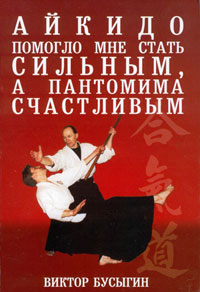 We wish to inform you that Viktor Busygin’s book entitled Aikido Made Me Strong While Mime Made Me Happy’ was published this year. To purchase the book you need to call beforehand to discuss the time of arrival at our Club. The book costs 200 roubles.
We wish to inform you that Viktor Busygin’s book entitled Aikido Made Me Strong While Mime Made Me Happy’ was published this year. To purchase the book you need to call beforehand to discuss the time of arrival at our Club. The book costs 200 roubles.
The Lithuanian Mime School. Modris Tenisons.
In my point of view, Modris Tenisons is a highly talented person and an intellectual to the very marrow of his bones. Modris has always been a true artist in the full sense of the word. After graduating from the School of Applied Arts in Riga he worked in Rigas Pantomima’ under Robert Lighers until he fell in love and emigrated to Lithuania, where he later went on to found his own mime theatre. I was amazed with his male beauty and elegance when we first met at the opening night of the Care for the Butterfly’ performance in Kaunas, Lithuania. He stood out in the crowd with his unusual mustache, beret, gait as well as his bearing. He was the one who lead the way. His status was seemingly unattainable for some people.
It was my dream to work with Modris. I wrote letters to him requesting a job but he always refused. I was anxious to learn the nature of the group and the principles of their work. I found answers to some of my questions in Modris’ memoirs, dedicated to the fifth anniversary of the group: “October 27th 1966 is the birth date of our group. The new group or the new theatre was founded by people with a huge desire to devote their lives to the art of mime. It was a wonderful and unique, yet difficult time. We worked really hard with great enthusiasm and, with hearts beating together, we opened our first Ecce Homo’ mime. It was introduced to the public five months after the creation of the group.
The green light for our professional activity given by the Ministry of Culture of the Lithuanian Soviet Socialist Republic has been our highest appraisal. The group and the philosophical Ecce Homo’ performance were awarded at the first mime festival of the Baltic Republic’s Riga 67’ in Latvia.
Our actors practiced drawing, painting and modelling. Musical exercises helped develop their sense of rhythm, harmony and composition, while improvisation developed their imagination, discipline and their sense of unity. Mime teaching was created at that time. We used some basic movements from modern ballet and modern dynamic dancing techniques to create Fugue’, our next performance. Our object was to reproduce the colour’ (though, spirit and mood) created by the great Lithuanian artist Mikaloyus Churlenis.
Following the first night of What Dreams Dream about’ we started on the children’s performance called Care for the Butterfly’. It was not easy to find a way to satisfy such an ingenious audience as children, but, I believe, we managed to do just that by introducing mime-like elements into our performance. Such elements, important in children’s communications are play, mime and fuelling the imagination. The 20th Century Capriccio’ set new harder goals for the actors to achieve. Being in a mime requires one to control one’s body and emotions perfectly and, at the same time, to be an artist, a human and a person of his epoch. Mime performances do not involve any costumes or scenery, which would reflect the epoch or the scene. These conditions require actors to be able to create a bond with the audience and make an idea of the performance clear to them.

The 20th Century Capriccio’ tells us about features of the lower middle classes which lead to fascism. The performance demonstrates the way fascism passes from exploiting brutish instincts and the demagogy of the lower middle classes to the destruction of cultural values. This is the conflict between art and the lower middle cases. The next performance of the group took place in the Kaunas State Musical Theatre (season 1970-71). Collage’ is a musical mime that tells about the endless road of Man seeking his Dream’ as well as his desire to learn the meaning of life.
The constant search for new ideas along with protests against clichés, primitive work and duplication, stimulate the group’s development.” Here is a list of actors from the Lithuanian mime theatre: Vitautas Petrushkyavichus, Gedryus Matskyavichus, Valeriy Martynov, Alghis Paplauskas, Ramunas Yanulaitis, Niele Storik, Yurate Mikshite, Zigmas Banevichus, Regina Putnayte, Eduards Pavlyukonis.
It is very hard, virtually impossible, to describe a mime performance. As they say, a diagram is worth many words. I cannot describe the delight I felt when watching each and every movement of the actors and listening to every breath taken. A word is merely a sound. You cannot listen with your eyes or see with your ears. Human visual organs perceive 90% of the total information.
I have now seen three performances staged by Modris Tenison, which are Care for the Butterfly’, 20th Century Capriccio’ and Collage’. Thanks to my good eyesight, I was able to see the actors communicating with each other and drawing with their bodies. I understood the director’s idea and perceived the way it was conveyed to us by the actors. Mime, like music, is impossible to describe. In order to realize the main idea of the mime performance you have to be in the right mood. You have to concentrate your mind and watch the stage very attentively. I suppose I should stop trying to describe the performances I’ve seen. All I can say is all three were performed brilliantly. The actors’ emotions were deep and real. Their technique, teamwork and mimicry were highly professional.
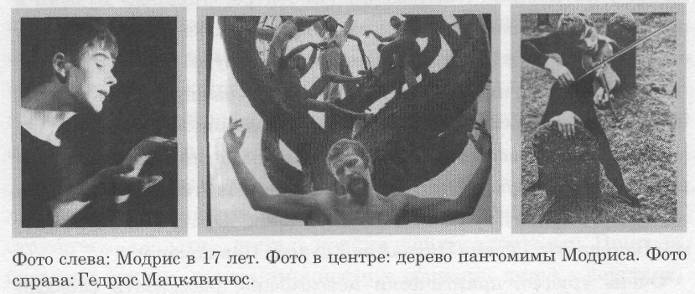
When describing my friend Modris Tenisons, I would like to add that he is an artistic person and a subtle aesthetic. It is always interesting to talk to him. He is a man of few words and emotions who radiates amazing friendliness and exposes his inner world full of new ideas during a conversation. He keeps creating, drawing and studying space and dimensions. Currently, Modris is not as thoroughly engaged in mime as he used to be. He is researching the symbolism of the Lielvardes josta’, a traditional woven belt with 22 ancient symbols. This Latvian ethnic group is a major part of his creative work. His website www.zime.lv is a kind of symbolic horoscope. It is open for everyone to receive their personal symbol and write a message to the world and the next generation.
As for Modris’ private life, he had to leave Kaunas and Moscow, where he had dedicated himself to mime and had lots of plans and dreams for the future, for his native Riga. I followed his example for a while. Occasionally, he was engaged in theatrical activities after he got married. His family was involved in a horrible car accident, which claimed the life of his wife Ilza and caused serious injuries to Modris and his children. It is all history now, but the consequences of the accident keep haunting him by affecting his health. His adult sons Yuveris and Peteris work and study in England and Cambodia respectively. He lives with his daughter Ilze and assistant, friend and a life partner Simona. I keep seeing him and we always have something to talk about, though our old friendship has taught us to understand each other without saying a word.
Modris Tenisons is loved and respected by Lithuanians, who consider him as a kind of local Charlie Chaplin’. Modris was honoured by the Lithuanian government with an Order of Gedeminos for his great contribution to the art of mime. He’s been retired for two years now but keeps drawing and attracting orders as an artist. He will always be a legend of Soviet mime in Latvia and beyond.
Let us keep in mind, it was Latvia that hosted the first Soviet Mime Festival in October 1967. The following is an extract from the Rigas Balss’ newspaper of that period:
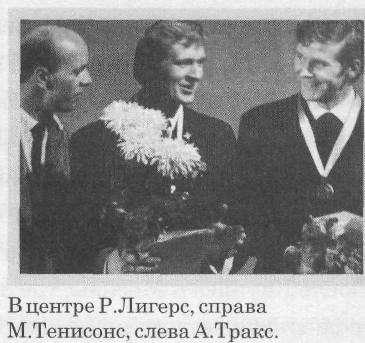 The first mime festival has taken place in Riga. This three-day festival involved mime enthusiasts from Kaunas, Tallinn and Riga all showing their performances in front of judges comprising well-known directors, composers and other experts.
The first mime festival has taken place in Riga. This three-day festival involved mime enthusiasts from Kaunas, Tallinn and Riga all showing their performances in front of judges comprising well-known directors, composers and other experts.
First place was shared by Rigas Pantomimas’ under Robert Liger and the group of the Kaunas State Theatre of Drama under the leadership of the ex-member of Rigas Pantomimas’ Modris Tennison. The Tallinn Youth Palace of Culture group (directed by Adolf Traks) took third place.
The Best Direction Award was given to Robert Liger. The Best Experimental Work Award was given to Modris Tenisons. Ecce Homo’ was awarded the Best Philosophical Mime Performance. Felix Baioras was awarded for the music featured in Ecce Homo’.
The group from Riga was awarded the Best Comic Mime, Best National Theme, Best Script and Best Styling.
Gedrius Matskiavichus from Kaunas was awarded Best Male Actor. Nadezhda Bogdanova from Riga was awarded Best Female Mime Artist.
Valeriy Martynov, a great friend of mine!
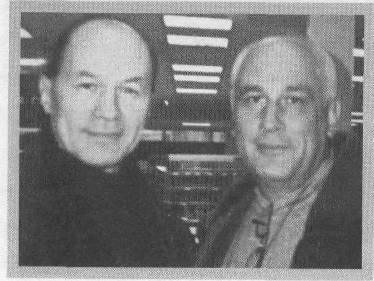 To begin with, I would like to say I’m very proud to have such a friend. We’ve been real friends for more than forty years now. I became acquainted with Valeriy Martynov in Kaunas on March 16th 1969. It was the Opening Night of the Care for the Butterfly’ performance, which I and my mime group R.P.’ came to watch. When the performance was over we met colleagues in the lobby for a chat. All of the actors could speak Russian, but that night they mostly spoke their native Latvian or Lithuanian. I spoke neither of those Baltic languages so I didn’t feel as though I belonged there. Valeriy and I were the only Russians so I came up to him to tell him something and our friendship clicked right away. He proved to be a very interesting person to talk to. I asked him some questions about their work and training as well as his thoughts and understanding of the art of mime. I learned from his answers that, besides mime, they practiced sculpture and painting to develop their perception of different objects. Some of the mime-actors’ work was displayed in the lobby. I was astonished by the beauty of these exhibits as soon as I saw them! The mime actors had used clay or wood to make their sculptures. Their pictures were created with water-colours, gouache or oils.
To begin with, I would like to say I’m very proud to have such a friend. We’ve been real friends for more than forty years now. I became acquainted with Valeriy Martynov in Kaunas on March 16th 1969. It was the Opening Night of the Care for the Butterfly’ performance, which I and my mime group R.P.’ came to watch. When the performance was over we met colleagues in the lobby for a chat. All of the actors could speak Russian, but that night they mostly spoke their native Latvian or Lithuanian. I spoke neither of those Baltic languages so I didn’t feel as though I belonged there. Valeriy and I were the only Russians so I came up to him to tell him something and our friendship clicked right away. He proved to be a very interesting person to talk to. I asked him some questions about their work and training as well as his thoughts and understanding of the art of mime. I learned from his answers that, besides mime, they practiced sculpture and painting to develop their perception of different objects. Some of the mime-actors’ work was displayed in the lobby. I was astonished by the beauty of these exhibits as soon as I saw them! The mime actors had used clay or wood to make their sculptures. Their pictures were created with water-colours, gouache or oils.
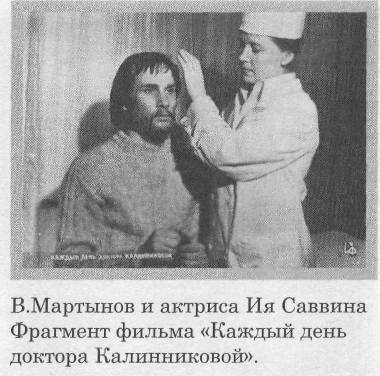 The obligatory task of making sculptures or pictures had been instigated by the director of the group, Modris Tenisons, an artist by trade. Every mime artist coped well with the task. Valeriy described and demonstrated many interesting things, such as the way they performed a wave with their bodies. It was something we had never done in R.P’. He told me about a play's composition and its complementary elements, about group miming and partnership mime plays, i.e., the secrets of mime art. He also told me about some special exercises, which allowed the Lithuanian mime artists to move with unique lightness, elegancy and freedom. Every one of Modris Tenisons’ actors had a special feature or, rather, a secret. I really loved it and I wished so hard I could join the Lithuanians one day. It was Valeriy Martynov who introduced me to the group and brought my dream closer to reality.
The obligatory task of making sculptures or pictures had been instigated by the director of the group, Modris Tenisons, an artist by trade. Every mime artist coped well with the task. Valeriy described and demonstrated many interesting things, such as the way they performed a wave with their bodies. It was something we had never done in R.P’. He told me about a play's composition and its complementary elements, about group miming and partnership mime plays, i.e., the secrets of mime art. He also told me about some special exercises, which allowed the Lithuanian mime artists to move with unique lightness, elegancy and freedom. Every one of Modris Tenisons’ actors had a special feature or, rather, a secret. I really loved it and I wished so hard I could join the Lithuanians one day. It was Valeriy Martynov who introduced me to the group and brought my dream closer to reality.
The mime artists of the Kaunas Theatre shared a local hostel at that time. Valeriy and Yurata, his wife and fellow performer, shared a room in a 3-room-flat in the hostel. Another room was occupied by Zigmas Balnevichus and Ghedrus Matskevichus. Two other mime artists lived in the third one. The kitchen was, of course, a communal area. Besides the disorder, which was normal for a communal flat, every room had its own features.
The interior design, the pictures and the drawings on the walls reflected the individuality of the occupants. As for me, there was not really much to tell about my work with Robert Ligher in R.P.’, since I had worked in the group for only one year and learned little. Besides, Robert’s approach to mime was very different than that of Modris’. During my conversations with Valeriy we would often discuss which of the two directors was better, Robert Ligher or Modris Tenisons, the teacher or his student. More and more I longed to join the Lithuanian mime theatre. Valeriy proved to be a real friend. On seeing my desire for the group and my interest in the training methods, he was glad to share his ideas with me and help me with advice. I began travelling to Kaunas to meet Valeriy and Yourata at least once a year. While working as mime artists in the theatre, the spouses moonlighted by performing in local restaurants. Restaurant variety shows were becoming popular in the Soviet Union at that time, so Valeriy and his wife were in great demand with their performances. It was a time when jazz was only just developing and mime was at the forefront. During one of my visits they invited me to the restaurant to watch their show. The performance I saw that night literally stunned me and infected me with the idea to do something similar. The show involved a winged’ Yurata and a half-naked Valeriy bound up with chains and with a candle in his hand. They performed a philosophical mime – the unchaining of a man thanks to his dream personified by a birdwoman. When the show was over, Valeriy advised that I should try and do my performance in a Riga restaurant. He said they paid well and didn’t limit one’s freedom of creation in restaurants. I spent the next year creating and practicing my mime solo (I couldn’t find a decent partner to join me). I wasn’t involved in many projects in R.P.’, R.Ligers didn’t pay much attention to me knowing my passion for Lithuanian pantomime, so I left the group for the Youras Perle’ variety theatre. Then our friendship with Valeriy continued on a new level.
Before working with Modris Tenisons, Valeriy was the leader of a local mime group in his native city of Gorki. He also commuted from Gorki to Riga to work with Robert Ligher for a while. I joined R.P.’ after he had already left the group for Modris Tennison’s theatre. With his inquiring mind, great erudition and excellent mime technique he could find his own style and methods of work, train his students and create performances on his own.
Kaunas witnessed a mass political riot in 1971. This horrible and tragic event happened near the theatre. A young man, who was a big fan of the Lithuanian mime, committed public self-immolation as an act of protest against the regime. The event was followed by a youth demonstration, which was quickly dispersed with the involvement of tanks. As a result of those events, Modris Tenisons, Valeriy Martynov and another mime artist, Zigmus Balnevichus, were fired with no explanations. The three actors found themselves in a desperate situation with no money and no work.
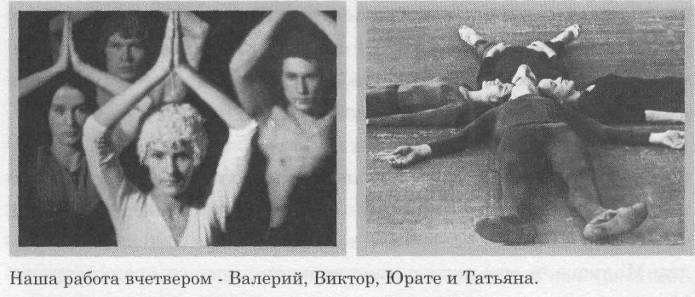
The crucial phone-call from the famous film actor and director Rolan Bykov to Modris and was a real salvation for the jobless mime artists. Mr. Bykov needed a group of mime artists for his new program in the Moscow Music Hall. After receiving the call from Moscow, Modris called Ansis to Riga and suggested they work in the Capital. Ansis, in turn, called me with the same offer and I, of course, agreed. I started working in one team with Valeriy Martynov and Modris Tenisons in the Leonid Utesov Moscow Music Hall in November 1972. Engaged in the labour of love, I worked under my favourite actor Rolan Bykov and, in addition, got paid one hundred and fifty roubles monthly. I had everything I had ever dreamed of! By the way, I hadn’t come to Moscow alone but brought along my girlfriend and student, Tatyana. I had worked with her in the Lido’ restaurant variety show in Riga. Despite her being a poor mime artist and a terribly capricious person we soon got married. She became my first wife and my first woman. All the mime artists worked really hard in the Music Hall’. We rehearsed and worked over our performances, our skills and flexibility every morning. The trouble came from an unexpected quarter. A long-lasting argument over the Music Hall’ management between the local director Mrs. Zviaghina and Rolan Bykov developed into a serious conflict. I remember the meetings involving verbal abuses and accusations in front of the group. We could do nothing, but wait for the outcome. Mrs. Zviaghina won the fight, Mr. Bykov left the hall and the mime artists lost their inspiration and original employer. Valera, Yourata, Tanya and I formed a group to work separately. Soon we developed great teamwork under our leader Valeriy and decided to demonstrate our skills to the director of the Taganka’ Theatre, Yuriy Lyubimov. We didn’t expect that he would love our performance and invite us for a second meeting when the theatre would be back from its upcoming tour in France. It was a chance for us to keep creating. Valeriy has a talent at easily making friends with interesting people. The art director of the Znanie - sila, Yuriy Sobolev, and the manager of an audio recording studio, Mr. Malkov, were typical examples.
Creative life in Moscow was, at that time, buzzing as usual, with its amazing diversity. Yuriy Lyubimov allowed us to watch the whole repertoire of the Taganka’ Theatre. We could rehearse and experiment in Mr. Malkov’s audio recording studio. Finally, we worked with psychiatrists. We created and experimented 24/7. Valeriy and I established mutual understanding, brotherly love and an identity of views. On the other hand, we didn’t have enough money to buy food and pay the rent. Quarrels broke out between Tatyana and I frequently. The quarrels caused nervous breakdowns and conflicts with the rest of the group. My wife got fed up with Moscow and our endless creative rush, so she left the Music Hall’ in 1973. In addition to the searing heat, the city was smoggy because of the peat-bog fires in the Moscow area. Then I learned that my favourite clown, Leonid Yenghibarov, had passed away. I had admired his talent. I had not been acquainted with him but I had seen his performances in circus. Before he died, Leonid Yenghibarov created his own mime theatre and the Clown’s Tricks’ performance. The death of this genius clown, along with the other events, made me fall into depression.
I was caught between a rock and a hard place’ and I had to decide whether I should stay in Moscow or follow Tatyana to Riga. After long consideration I chose the second alternative. It was very hard for me to tell Valeriy about my decision.
(from Viktor Busyghin’s book Aikido Made Me Strong While Mime Made Me Happy’)



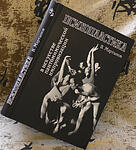

 Коан – вопрос к членам Федерации Юн Чун Цюань от президента В.В. Мартынова: «Что Вы сделали для Федерации из того, что не мог бы сделать любой другой за деньги?»
Коан – вопрос к членам Федерации Юн Чун Цюань от президента В.В. Мартынова: «Что Вы сделали для Федерации из того, что не мог бы сделать любой другой за деньги?»
